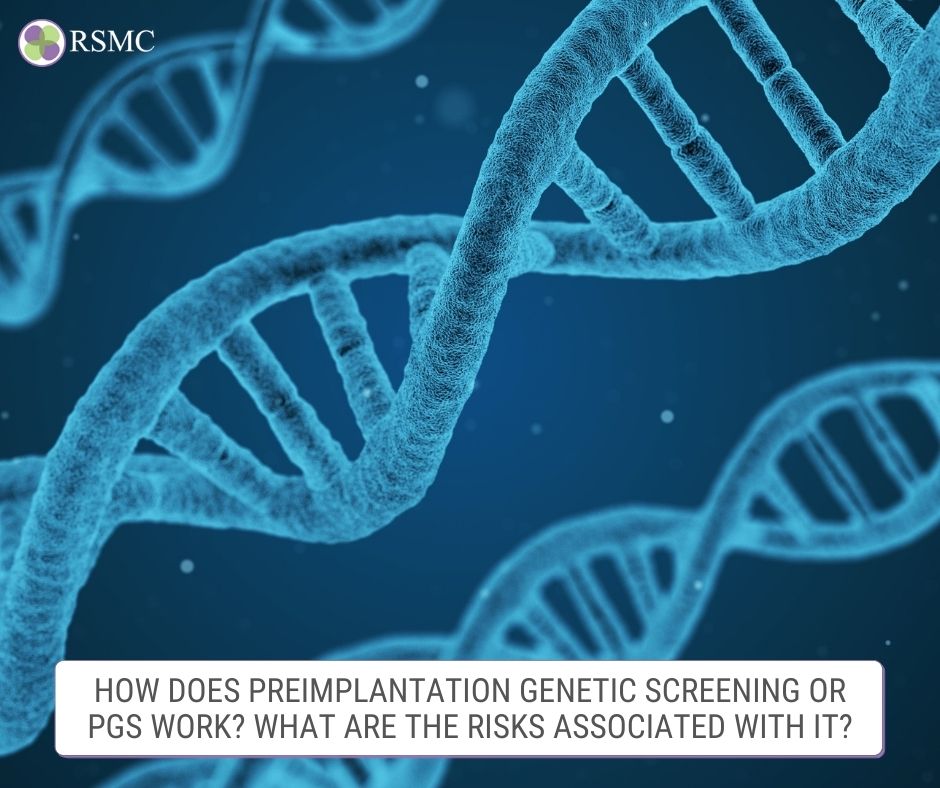PGS testing, also known as PGT-A, is a medical procedure that is carried out to select the best embryo for transfer during IVF. PGS genetic testing can improve IVF success rates by identifying the best quality and chromosomally normal embryos.
But while the PGS test helps reduce the odds of an IVF failure, it has its own risks. For this test, a few cells are removed from a developing embryo, and their genetic material is evaluated. In the following piece, we will discuss what PGS means, how it works, and whether it causes any harm to the embryo.
What is preimplantation genetic screening?
The term preimplantation genetic testing or embryo biopsy refers to techniques used to detect chromosomal or genetic abnormalities in embryos created through IVF (in vitro fertilization). There are two different tests for evaluating embryos: preimplantation genetic diagnosis (PGD) and preimplantation genetic screening (PGS).
PGS checks for multiple chromosome abnormalities or genetic disorders (which affect around 25-28% of all embryos, depending on the age of the woman). Aside from playing a role in many diseases, studies have shown that chromosome abnormalities can raise the chance of pregnancy loss and unsuccessful IVF.
Genetic testing can help lower the chances of passing on heritable debilitating diseases in individuals or couples who are at risk of transferring these to their children. It can also help improve the chances of a successful pregnancy by checking for genetic issues that can have a negative impact on pregnancy and childbirth.
Quick facts about PGS Testing Risks
Preimplantation genetic screening (PGS) is a testing procedure conducted on IVF embryos to evaluate their chromosomes for net loss or gain of genetic materials. PGS can help identify certain chromosomal abnormalities, including Down syndrome, Turner Syndrome, and Klinefelter syndrome.
- PGS testing helps select the best embryo to transfer into the womb.
- Embryos containing the right chromosome numbers are known as euploid embryos, and they might have a better chance of resulting in a healthy pregnancy, although the evidence behind this is a bit controversial. Women older than 35 seem to benefit the most from PGS genetic testing.
- There is some scientific evidence that embryos can be destroyed during the PGS process, but it is unclear.
- A euploid embryo is not easy to get. Not every embryo grows to become blastocysts, and not all blastocysts are going to be euploid.
- Although transferring a euploid embryo can increase the chance of achieving a pregnancy, it can still fail.
- The results of PGS testing may be inaccurate, and sometimes, an abnormal embryo may not truly be abnormal after all.
- Aneuploidy or an abnormal number of chromosomes – aneuploidy is the presence of an incorrect number of chromosomes in a cell, i.e., having 47 or 45 chromosomes instead of 46. Examples of aneuploidy include:
- Edward’s Syndrome with an additional copy of chromosome 18
- Down Syndrome with an additional copy of chromosome 21
- Translocation or re-arrangement of one part of the chromosome onto another chromosome
- Omission or deletion of one segment of chromosome or
- Sex-chromosome disorders, including deletion or duplication of X and Y chromosomes. Some examples of sex-chromosome disorders are
- Turner Syndrome with just one copy of sex chromosome (one X)
- Klinefelter Syndrome with three copies of sex chromosome (two X and one Y)
Who is PGS For?
Since PGS checks embryos for chromosomal defects, it is more precise at detecting embryos with normal chromosome makeup compared to visual microscopic observation often used in IVF. Therefore, PGS makes it possible to select a normal embryo for transfer, increasing the chances of giving birth to a healthy baby.
Individuals or couples who are at higher risk of having embryos with abnormal chromosomes are good candidates for PGS. These include women of:
- Advanced reproductive age (35 and above)
- Repeated pregnancy losses
- Previous unsuccessful IVF cycles
- Other good candidates for this test are couples or individuals who want to have a single embryo transfer in order to maximize the possibility of a healthy baby through IVF or balance their family
How does preimplantation genetic screening work?
There are several methods that can be used to check all the 24 chromosomes, also known as comprehensive chromosomal screening (CCS). The most common ones include:
- Array-Comparative Genomic Hybridization (aCGH) and
- Next-generation Sequencing (NGS)
Both testing methods are conducted using several cells removed from a day 5 or day 6 embryo or just one or two cells from a day 3 embryo.
What are the Steps Involved in PGS?
The whole process of PGS includes multiple steps, and each of them is handled by different professionals and laboratories.
- The first step is IVF (in vitro fertilization) using either traditional IVF or intracytoplasmic sperm injection (ICSI) to create the embryos. Fertilized embryos are then placed in a culture medium for about 3-5 days. This part takes place at the fertility clinic.
- The second step is embryo biopsy, which is carried out on day 3 or day 5 of embryo development
- For the biopsy of a day 3 embryo, one or two cells are removed for testing
- For the biopsy of a day 5 embryo, many cells (3 to 6 cells) are removed for testing
The cells of a day 5 or day 6 embryo would have differentiated into two types:
- cells that will form the placenta (trophectoderm) and
- cells that will form the fetus
At this stage, more cells can be removed from the embryo’s outer layer without it becoming less viable, resulting in a more precise test.
A day 5 embryo biopsy
- Once the cells are collected and put in test tubes, these tubes are sent to an external laboratory for analysis using a same-day overnight courier service.
- The cell is then analyzed for chromosomal or genetic abnormalities.
- It usually takes more than 24 hours before the test results come out. Therefore, it is important to freeze the embryos via a fast freezing method known as vitrification.
- The last step – the thawing of the frozen embryo and its transfer back into the womb – is carried out at the fertility clinic.
What are the possible risks of PGS?
The risks associated with PGS treatment are quite similar to those for traditional IVF.
However, with PGS, there is a chance that:
- Some embryos will get damaged in the process of cell removal
- No or unclear result due to a technical problem
- Wrong result due to chromosomal mosaicism in the embryo.
(Mosaicism is when an embryo or individual has two or more cells with different chromosomal composition).
PGS testing on a cleavage stage embryo is usually conducted by removing one or more cells and sending them for testing. But since there are only a few cells to start with, does this cause damage to the embryo?
Yes. According to a 2013 study, researchers discovered that the chances of successful implantation were lowered by 39% if cells are removed from a cleavage stage embryo.
It is obvious how this could cause damage to the embryo – what if the cell or cells removed are essential for embryo development?
Since there are only a few cells present at this stage, PGS testing can pose harm to the embryo. However, with blastocysts, there are many cells.
Does biopsying a blastocyst-stage embryo harm the embryo?
Blastocyst culture (the process of growing embryos to the blastocyst stage) has become the norm in recent years, and a blastocyst-stage biopsy is typically considered superior to biopsy of an embryo in the cleavage stage.
As you can see above, the biopsy of a cleavage stage embryo can cause serious harm, maybe because there are only a few cells to begin with. Blastocyst-stage embryos, on the other hand, have many cells in their outer layer (trophectoderm), so removing a tiny piece should not cause much damage, right? Actually, it is not yet clear!
As per a 2013 study, embryo biopsy does not cause any damage, and biopsied embryos had the same chances of implantation as non-biopsied embryos. However, some other studies have indicated the opposite.
About 5 to 6 cells are removed during an embryo biopsy, but what if you remove a larger piece?
This is exactly what a 2014 study considered. The researchers found that pregnancy rates were lowered when a bigger piece was removed from an embryo, probably because of the embryo’s inability to recover which is why only a small piece is usually being removed in the process.
The stage of the embryo when PGS is performed
The stage of embryo development at the time of biopsy may have a huge impact. A 2019 study discovered that embryos had better implantation chances if the biopsy was conducted when they are expanded and getting out of the zona. And the success rates were significantly lower for embryos biopsied too early in their developmental stage, probably due to the damage caused by the procedure itself.
Another study stated that about 17 to 39% of embryos might be lost during the embryo biopsy process. The researchers arrived at this figure after checking the results of a large study where PGS (preimplantation genetic screen) failed to perform as well as expected.
So PGS testing can cause harm to the blastocyst, and this may have a significant impact on the success rates. Although removing a right-sized piece and biopsying the cells at the right developmental stage can help minimize the damage, there may be some other factors at play that we are yet to know.
Does PGS testing improve success rates?
The success rate of an IVF cycle in conjunction with PGS genetic testing depends on if any and how many of the embryos created through IVF have a normal PGS result.
Many PGS experts suggest that the advertised PGS success rates may be a bit lower than advertised. Intended Parents often learn that PGS-normal embryos have a 60–70% success rate, although, that is actually on a per-transfer basis.
However, recent data shows that an elective single frozen embryo transfer has a live birth rate between 60-80% when done in a subsequent cycle. These data are very promising since a lot of women who undergo IVF and PGS are more likely to produce embryos with an abnormal number of chromosomes, whether due to advanced reproductive age, repeated pregnancy losses, or previous IVF failures.
Although a 2015 review of studies comparing PGS testing with no testing concluded that it is beneficial overall.
A large study conducted in 2019 indicated that the 35-40 group had better success rates with PGS with the ongoing pregnancy rate increasing from 37.2% to 50.8%.
However, in some cases, there may be no suitable embryos to transfer into the uterus. This may be because:
- All the embryos created are aneuploid (contain an incorrect number of chromosomes)
- Not enough eggs are fertilized or produced
- The embryos got damaged while removing the cells.
Does PGS testing reduce miscarriage rates?
According to a 2018 committee report, there is data that PGS testing lowers miscarriage with more studies on the way to research this correlation.
In conclusion, PGS testing is more beneficial to women above 35 due to the egg quality reducing as a woman becomes older and makes more embryos to be aneuploid or chromosomally abnormal. Remember, euploid embryos are needed for IVF to work, and even then, success is not guaranteed.
RSMC offers in-house PGS testing and 40+ customized IVF treatment plans to maximize your pregnancy success rate. If you still have questions regarding PGS genetic testing and how RSMC ensures that the risks of PGS damage to the embryo are very low, simply schedule a consultation with our fertility specialists.
You can also inquire through our chatting option.























